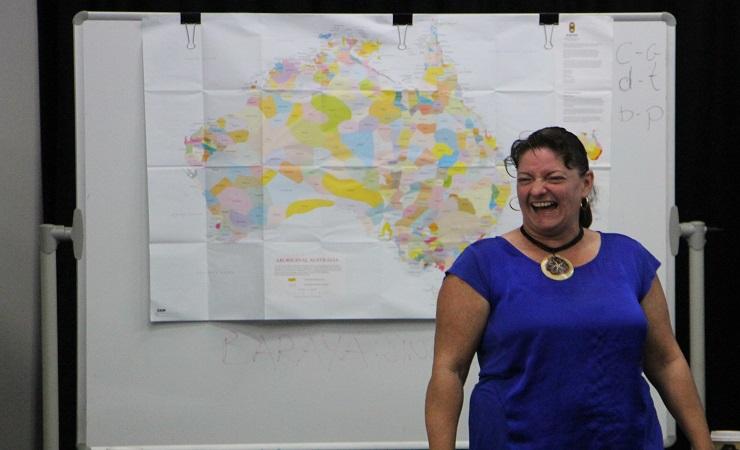ASIACALLING
Reviving Aboriginal languages
"In Sydney Australians are starting to learn one local Aboriginal language. It’s part of a growing movement to help revive and save the almost 120 Aboriginal languages spoken in Australia today."
Jarni Blakkarly

Many of us may have sat in a classroom and learnt a language other than our mother tongue.
And that’s where this next story takes us, into a classroom in Sydney, where Australians are starting to learn one local Aboriginal language.
It’s all part of a growing movement to help revive and save the almost 120 Aboriginal languages spoken in Australia today.
Jarni Blakkarly has more.
Budjari Mulinawal, good morning. It’s a Saturday morning and I’m heading to language class to learn some Darug.
It’s the language spoken by the many of the Aboriginal clan groups in and around the area we now call Sydney, and part of the one of the oldest cultures in the world.
There are roughly 120 Indigenous languages still spoken today and many of them, like Darug, are being revived.
There are roughly a dozen people in this class – retirees, high-school teachers and an electrician.
Aunty Jacinta Tobian has been teaching Aboriginal culture, songs and ceremonies for almost 20 years. She says it’s been heartening to see the increasing interest in learning Aboriginal languages from the broader community.
“I’m really grateful that people are wanting to learn and you know I heard some Australians [say] that it’s a dead language. It’s only because we don’t understand the language,” said Jacinta.
![]()
There were roughly 250 languages spoken throughout the continent when the British colonised Australia.
But through the violence of colonisation more than half were lost.
“A lot of Australians or the world don’t realise we were not allowed to speak the culture, the language. Sometimes people think we were too lazy to teach our kids the language, well that’s not true, it was a fear of your child being taken,” explained Jacinta.
Of the 120 indigenous languages remaining, almost 100 of them are in danger of becoming extinct, as it’s mainly elder members of the community who know them.
That’s led to a recent push to save them. And technology is playing a big part of it.
Several smartphone apps have been developed for kids to learn indigenous languages as well as online courses and classes like this one.
One those attending the class is Tash Caldwell, she works for a local government and she is Indigenous herself. Her people come from the northern state of Queensland and she missed out on learning her language.
“ I didn’t actually get the chance to learn language growing up, from my own mob, so I just thought it was a good opportunity to learn the local language where I’m living. This has probably encouraged me to do that, to get back in touch with some of my mob who do speak fluently language,” said Tash.
Romina is from Italy and like many Europeans is backpacking around Australia. She joined the class to learn more about Aboriginal culture.
“We don’t know anything about Australia in Europe, like anything at all. So I just started to read something about Australian history and how it begin the colonisation and everything,” Romina told me.
“I was really surprised about the fact that I have the feeling you cannot really see around, any sign of the past,”
Romina speaks four languages. However for Australians speaking a second language is rare. It is estimated more than 80% of Australians only speak English.
And while the government is hoping to increase the numbers of kids who speak a foreign language, many Indigenous groups are pushing for Aboriginal languages to be taught in schools as well.
Gadigal is one of the several Aboriginal tribes that traditionally lived in the area around Sydney.
![]()
Joel Davidson is a Gadigal man, and he grew up in Sydney. He only began learning Darug 3 months ago, and now he is teaching the class, along with Jacinta.
He usually works as a web developer, but language is something he is becoming passionate about.
“You can’t detach the language from the culture and the history,” he said.
“I’m very passionate about teaching the culture and the history of Sydney Aboriginal people, and all Aboriginal people”
He says he hopes young Aboriginal people growing up now, will have the opportunity that he didn’t.
“It is embarrassing to tell people that you don’t know your own language. It is embarrassing to see people that because they don’t know their own language they don’t know their own culture and history, they don’t have anything to be proud of as Koori people,” said Davidson.
Aboriginal people make up roughly two point five percent of the Australian population, but it’s not known how many speak their traditional languages. Generally it’s a lot less common for Indigenous people living in the big cities like Sydney.
Davidson says that with half of the Aboriginal population under the age of 20, now is the time to start teaching.
“I think that being able to give the young ones their language back and being able to have them grow up with it, which is something I wasn’t able to do, would be the best gift in the world,” he said.
- Jarni Blakkarly
- Australia Aboriginal language
- Gadigal
- Joel Davidson
- Sydney Aboriginal culture
- Darug
- Jacinta Tobian
Komentar (1)
KBR percaya pembaca situs ini adalah orang-orang yang cerdas dan terpelajar. Karena itu mari kita gunakan kata-kata yang santun di dalam kolom komentar ini. Kalimat yang sopan, menjauhi prasangka SARA (suku, agama, ras dan antargolongan), pasti akan lebih didengar. Yuk, kita praktikkan!
Leo Kim6 years ago
Hi all I would love to contact Jacinta and Joel in relation to teaching Aboriginal language using Korean alphabet. Leo Kim [email protected]